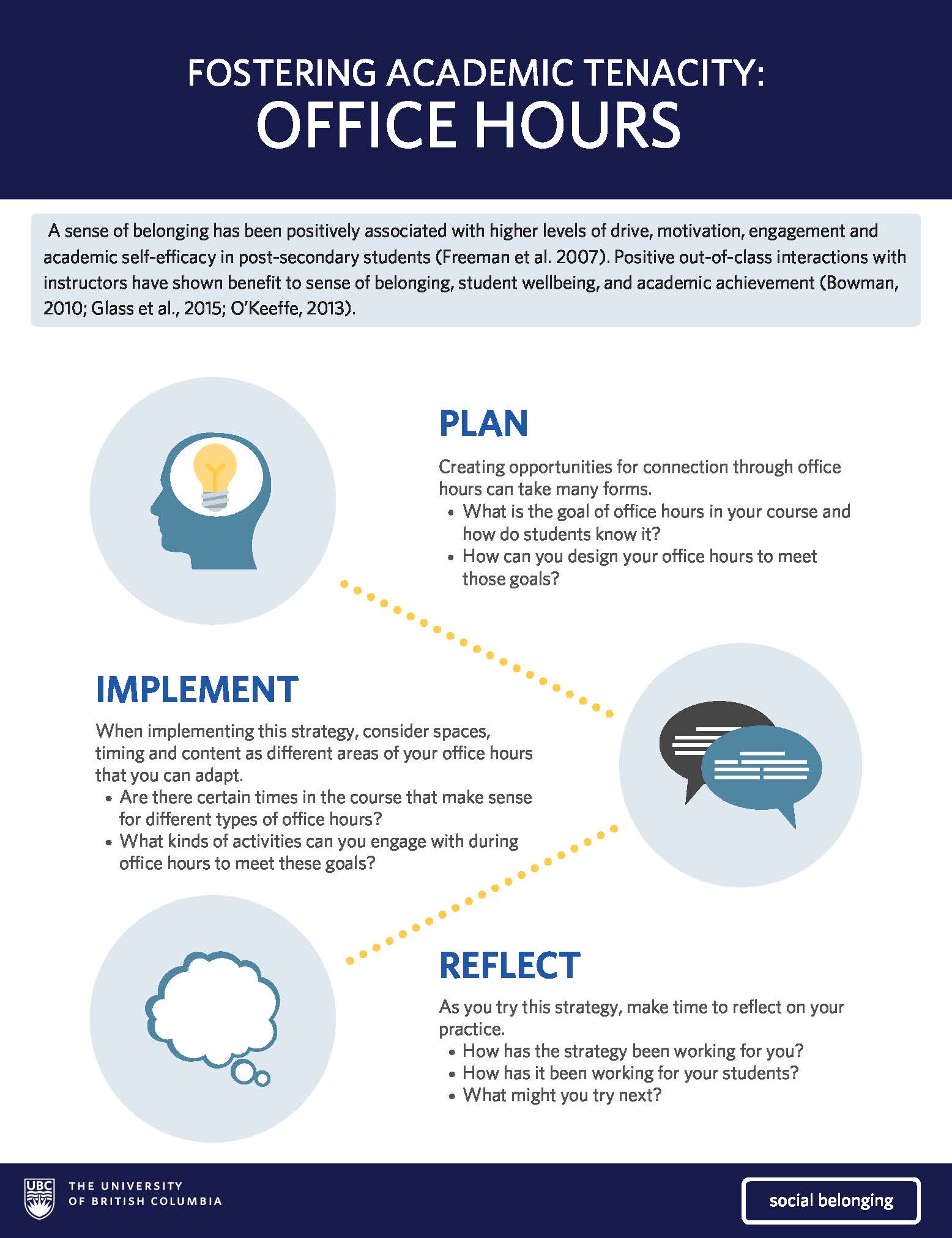Connection through Office Hours
Among post-secondary populations, a sense of belonging has been positively associated with higher levels of drive, motivation, engagement and academic self-efficacy (Freeman, Anderman & Jensen, 2007) Instructor encouragement of student participation and interaction, as well as students’ perceptions of their instructor’s warmth and organization, are positively linked to students’ motivation and achievement (Freeman, Anderman & Jensen, 2007; Patrick et al., 2001).
Office hours “represent the institutional commitment to student-faculty interaction” and is regarded as one of the best practices in undergraduate education (Smith et al., 2017, p. 14). Positive out-of-class interactions with faculty have been shown to benefit sense of belonging as well as student wellbeing and academic achievement (Bowman, 2010; Glass et al., 2015; O’Keeffe, 2013).
Promising Practices
Benjamin Y. Cheung teaches in Psychology and facilitates opportunities for his students to build community during their time at UBC. He introduced innovative office hours with a focus on connection into two undergraduate research methods courses. These office hours, also called Bagels with Ben, are a space where students meet in a group with their instructor, over bagels, to connect on topics that go beyond course content. They are opportunities for students to connect with their instructor and their peers in an informal space.
The impact of Bagels with Ben, and the introduction of study skill conversations in office hours was assessed with a key question in mind: How do interactions with instructors outside of class affect students’ perceptions of (1) belonging, (2) academic confidence, (3) departmental support, and (4) academic anxiety?
Key findings include:
- Students who attended Bagels with Ben showed better improvements in their sense of belonging than those who did not.
- Guided discussion of study skills may have led to improvements in intrinsic motivation and wellbeing scores. Students who believed themselves in control of their own ability to learn were more likely to report perceiving faculty as supportive.
Neil Armitage teaches in Sociology and strives to close the distance between himself, TAs and students through informal connection. He introduced centralized office hours into an introductory sociology course, where students could meet with the instructor and TAs in the “Learning Lounge” located in the The Chapman Learning Commons- a student space in the Irving K. Barber Learning Centre. These office hours provided opportunities for students to connect with their instructor and TAs outside the traditional academic office environment. In addition, for students who could not attend these weekly office hours due to their schedule, Piazza was used as an online virtual office, where students were encouraged to seek assistance from their peers, TAs and Neil.
The impact of this office hour model was assessed with a key question in mind: How does holding office hours together with TAs in a centrally located space together with an online virtual office impact student-faculty-TA interactions – specifically, students’ help-seeking behaviours.
Key findings include:
- Over the course of the class, students remained consistent in their willingness to seek help from their professor.
- Compared to the beginning of the course, students at the end of the course reported being more willing to seek help from the TA, from someone besides the TA, or the instructor and being more willing to seek help outside of class in general.
- Students who attended office hours and used Piazza showed greater improvements in their willingness to seek help from a TA.
Selected References and Measures
-
Bowman, N. A. (2010). The development of psychological well-being among first-year college students. Journal of College Student Development, 51(2), 180-200.
-
Freeman, T., Anderman, L. & Jensen, J. M. (2007). Sense of belonging in college freshmen at the classroom and campus levels. The Journal of Experimental Education, 75:3, 203-220.
-
Glass, C. R., Kociolek, E.,Wongtrirat, R., Lynch, R. J., & Chong, S. (2015). Uneven experiences: The impact of student-faculty interactions on international students' sense of belonging. Journal of International Students, 5(4), 353-367.
-
O’Keeffe, P. (2013). A sense of belonging: Improving student retention. College Student Journal, 47(4), 605–613.
-
Patrick, H., Anderman, L. H., Ryan, A. M., Edelin, K. C., & Midgley, C. (2001). Teachers’ communication of goal orientations in four fifth-grade classrooms. The Elementary School Journal, 102, 35–58.
-
Smith, M., Chen, Y., Berndtson, R.,Burson, K. M., & Griffin, W. (2017). "Office hours are kind of weird": Reclaiming a resource to foster student-faculty interaction. InSight: A Journal of Scholarly Teaching, 12, 14.
Selected Measures
- Tovar, E., & Simon, M. A. (2010). Factorial structure and invariance analysis of the sense of belonging scales. Measurement and Evaluation in Counseling and Development, 43(3), 199-217. doi:10.1177/0748175610384811
- The University of British Columbia (2018). The undergraduate experience survey 2018.
- Zandvliet, D. B., Stanton, A., & Dhaliwal, R. (2019). Design and validation of a tool to measure associations between the learning environment and student well-Being: The healthy environments and learning Practices survey (HELPS). Innovative Higher Education, 1-15.
Go Further
Recommended Citation: Health Promotion & Education, UBC. (2019). Fostering academic tenacity: Connection Through Office Hours. Retrieved from: wellbeing.ubc.ca/wble
We gratefully acknowledge the financial support for this project provided by UBC Vancouver students via the Teaching and Learning Enhancement Fund.
